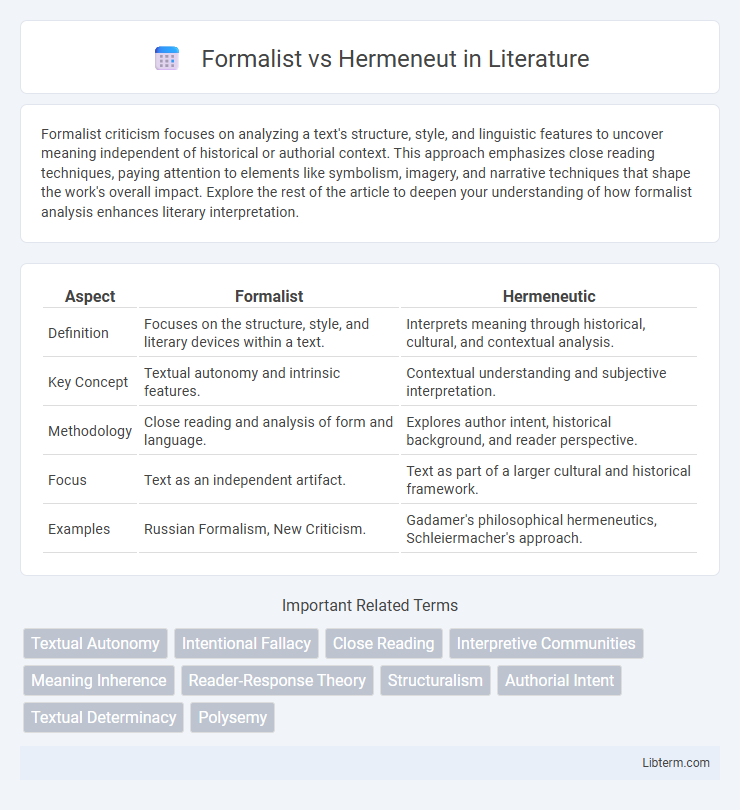Formalist criticism focuses on analyzing a text's structure, style, and linguistic features to uncover meaning independent of historical or authorial context. This approach emphasizes close reading techniques, paying attention to elements like symbolism, imagery, and narrative techniques that shape the work's overall impact. Explore the rest of the article to deepen your understanding of how formalist analysis enhances literary interpretation.
Table of Comparison
| Aspect | Formalist | Hermeneutic |
|---|---|---|
| Definition | Focuses on the structure, style, and literary devices within a text. | Interprets meaning through historical, cultural, and contextual analysis. |
| Key Concept | Textual autonomy and intrinsic features. | Contextual understanding and subjective interpretation. |
| Methodology | Close reading and analysis of form and language. | Explores author intent, historical background, and reader perspective. |
| Focus | Text as an independent artifact. | Text as part of a larger cultural and historical framework. |
| Examples | Russian Formalism, New Criticism. | Gadamer's philosophical hermeneutics, Schleiermacher's approach. |
Introduction to Formalism and Hermeneutics
Formalist criticism centers on analyzing a text's structure, style, and linguistic features without considering external contexts like author background or historical setting. Hermeneutics involves interpreting texts by exploring meaning through historical, cultural, and philosophical contexts, emphasizing the reader's role in uncovering deeper significance. Both approaches prioritize distinct methods: Formalism focuses on intrinsic textual elements, while Hermeneutics engages with extrinsic factors for comprehensive understanding.
Historical Origins of Formalism
Formalism originated in early 20th-century Russia with the Moscow and Prague Schools, emphasizing the intrinsic features of literary texts such as structure, language, and literary devices, independent of historical or biographical context. The movement was rooted in a reaction against traditional literary criticism, which often relied on authorial intent or historical background, aiming instead to uncover how texts create meaning through defamiliarization and formal techniques. Key figures like Viktor Shklovsky and Roman Jakobson laid the foundation for Formalism by focusing on the mechanics of narrative and poetic form, distinguishing it sharply from Hermeneutics, which prioritizes interpretive understanding and contextual analysis.
Key Principles of Hermeneutic Theory
Hermeneutic theory centers on interpreting texts through understanding historical context, authorial intent, and the reader's perspective, emphasizing the fluidity of meaning rather than fixed interpretation. Key principles include the hermeneutic circle, where comprehension arises iteratively between parts and the whole, and the fusion of horizons, blending the interpreter's context with the original text's background. This approach contrasts with formalist theory by prioritizing meaning extraction over structural or linguistic analysis alone.
Core Differences: Text vs. Context
Formalist analysis centers on the intrinsic features of a text, emphasizing structure, language, and literary devices without considering external factors. Hermeneutics prioritizes context, interpreting meaning through historical, cultural, and authorial frameworks to uncover deeper significance. The core difference lies in Formalism's focus on the text as an autonomous entity, whereas Hermeneutics views interpretation as inseparable from surrounding context.
Major Proponents and Influential Works
Formalist criticism, pioneered by Roman Jakobson and Viktor Shklovsky, emphasizes the structural elements of a text, with key works like Shklovsky's "Art as Technique" highlighting defamiliarization as a central concept. Hermeneutics, advanced by Hans-Georg Gadamer and Paul Ricoeur, focuses on interpretative methodologies, with Gadamer's "Truth and Method" and Ricoeur's "Interpretation Theory" shaping modern understanding of textual meaning through dialogue and historical context. These competing approaches underscore the divide between analyzing formal features and exploring deeper interpretative layers in literature.
Approaches to Literary Analysis
Formalist literary analysis emphasizes close reading, focusing on structure, language, and literary devices within the text itself, disregarding external influences like author intent or historical context. Hermeneutic approaches prioritize interpretation based on historical background, cultural context, and the reader's perspective, seeking deeper meaning beyond the text's surface. Both methods offer distinct frameworks: Formalism centers on objective textual analysis, while Hermeneutics embraces subjective understanding and the evolving nature of meaning.
Strengths of the Formalist Perspective
The Formalist perspective excels in its rigorous analysis of a text's structure, language, and literary devices, allowing for an objective interpretation free from external influences like author biography or historical context. This approach emphasizes close reading and detailed examination of narrative elements such as syntax, symbolism, and form, which enhances the precision and clarity of literary analysis. The strength of Formalism lies in its ability to uncover intrinsic meanings within the text itself, providing a disciplined framework for understanding literature's technical artistry.
Advantages of the Hermeneutic Approach
The hermeneutic approach offers the advantage of deep contextual understanding by interpreting texts within their historical, cultural, and social frameworks, leading to richer, more nuanced meanings. Unlike formalist methods that focus on structure and form, hermeneutics emphasizes the subjective experience and intention behind the text, enhancing its relevance to contemporary readers. This approach fosters critical engagement and promotes multiple interpretations, accommodating diverse perspectives and evolving cultural contexts.
Criticisms and Limitations of Each Method
Formalist criticism is often criticized for neglecting historical and cultural contexts, limiting its analysis to text-internal elements and undermining broader interpretative richness. Hermeneutics faces limitations in its subjective interpretative nature, leading to potential bias and lack of reproducibility in understanding texts. Both methods struggle with balancing objectivity and depth, as Formalism can become rigidly narrow while Hermeneutics may become overly relativistic.
Formalism vs. Hermeneutics: Contemporary Relevance
Formalism emphasizes the intrinsic features of a text, focusing on structure, style, and literary devices, which allows for objective analysis independent of historical or cultural context. Hermeneutics centers on interpretation, stressing the importance of understanding a text within its socio-historical and authorial background, thereby promoting subjective and context-driven meanings. Contemporary debates highlight Formalism's value in establishing consistent analytical frameworks while Hermeneutics offers deeper insights into evolving interpretations shaped by societal changes and reader perspectives.
Formalist Infographic

 libterm.com
libterm.com